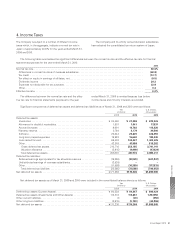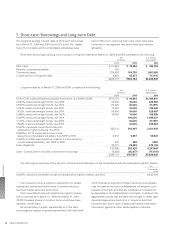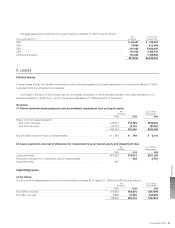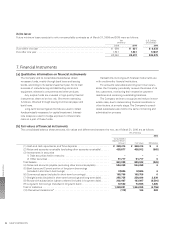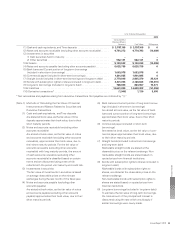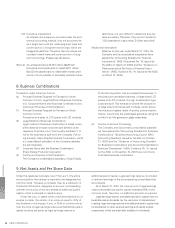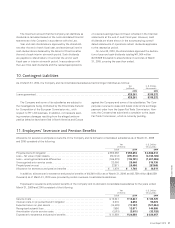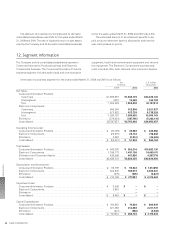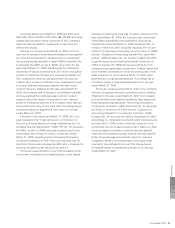Sharp 2010 Annual Report Download - page 63
Download and view the complete annual report
Please find page 63 of the 2010 Sharp annual report below. You can navigate through the pages in the report by either clicking on the pages listed below, or by using the keyword search tool below to find specific information within the annual report.
Corporate assets as of March 31, 2009 and 2010 were
¥442,849 million and ¥421,303 million ($4,579,380 thousand),
respectively, and were mainly comprised of the Company’s
cash and cash equivalents, investments in securities and
deferred tax assets.
Effective for the year ended March 31, 2009, the Com-
pany and its domestic consolidated subsidiaries have applied
the “Accounting Standard for Measurement of Inventories”
(Accounting Standards Board of Japan (ASBJ) Statement No.
9, issued by the ASBJ on July 5, 2006). As a result, for the
year ended March 31, 2009, operating loss for “Japan”
increases by ¥5,274 million, compared to amounts calculated
under the previous method. Also, valuation methods for raw
materials and work in process had previously been based on
the last invoice method. However, effective for the year
ended March 31, 2009, the Company and its domestic con-
solidated subsidiaries have adopted the moving average
method in order to properly reflect the impact of fluctuations
in raw material prices on financial statements, and to achieve
more appropriate periodic accounting of profit and loss. This
change has an immaterial impact on segmented information
for the year ended March 31, 2009.
Effective for the year ended March 31, 2009, the Company
has applied the “Practical Solution on Unification of Accounting
Policies Applied to Foreign Subsidiaries for Consolidated
Financial Statements” (ASBJ PITF No. 18, issued by the ASBJ
on May 17, 2006) and made revisions required for consolidated
accounting. As a result, for the year ended March 31, 2009,
operating loss for “The Americas” increases by ¥2,613 million,
operating income for “Europe” decreases by ¥135 million,
while operating income for “China” and “Other” increase by
¥910 million and ¥34 million, respectively, compared to
amounts calculated under the previous method.
Previously, lease payments under finance leases that do
not transfer ownership of the leased property to the lessee
had been recognized as expenses. However, effective for the
year ended March 31, 2009, the Company and its domestic
consolidated subsidiaries have applied the “Accounting
Standard for Lease Transactions” (ASBJ Statement No. 13,
revised on March 30, 2007 (originally issued by the 1st com-
mittee of the Business Accounting Council on June 17, 1993))
and the “Guidance on Accounting Standard for Lease Trans-
actions” (ASBJ Guidance No. 16, revised on March 30, 2007
(originally issued by the Auditing Standards Committee of
JICPA on January 18, 1994)) and are accounting for such
transactions as capital lease transactions. Finance leases that
do not transfer ownership for which the starting date of the
lease transaction is on and before March 31, 2008, lease
payments are recognized as expenses. This change has an
immaterial impact on segmented information for the year
ended March 31, 2009.
Previously, revenues and costs of construction contracts
had been recognized using the completed-contract method.
Effective for the year ended March 31, 2010, the Company
and its domestic consolidated subsidiaries have applied the
following accounting standards; “Accounting Standard for
Construction Contracts” (ASBJ Statement No. 15, issued by
the ASBJ on December 27, 2007) and the “Guidance on
Accounting Standard for Construction Contracts” (ASBJ
Guidance No. 18, issued by the ASBJ on December 27,
2007). Accordingly, for construction contracts which com-
menced on and after April 1, 2009, and for which the outcome
of the construction activity is deemed certain as of March 31,
2010, the percentage-of-completion method has been
applied, otherwise the complete-contract method has been
applied. Under the percentage-of-completion method, rev-
enue is recognized, based on the percentage of the actual
costs incurred of the estimated total cost. This change has an
immaterial impact on segmented information for the year
ended March 31, 2010.
Overseas sales for the years ended March 31, 2009 and 2010 were as follows:
Yen
(millions)
U.S. Dollars
(thousands)
2009 2010 2010
Overseas sales:
The Americas. . . . . . . . . . . . . . . . . . . . . . . . . . . . . . . . . . . . . . . . . . . . . . . . . . . . ¥ 488,428 ¥ 342,923 $ 3,727,424
Europe. . . . . . . . . . . . . . . . . . . . . . . . . . . . . . . . . . . . . . . . . . . . . . . . . . . . . . . . . 451,090 393,212 4,274,044
China. . . . . . . . . . . . . . . . . . . . . . . . . . . . . . . . . . . . . . . . . . . . . . . . . . . . . . . . . . 407,777 365,440 3,972,174
Other. . . . . . . . . . . . . . . . . . . . . . . . . . . . . . . . . . . . . . . . . . . . . . . . . . . . . . . . . . 197,671 225,316 2,449,087
Total. . . . . . . . . . . . . . . . . . . . . . . . . . . . . . . . . . . . . . . . . . . . . . . . . . . . . . . . . . . ¥1,544,966 ¥1,326,891 $14,422,729
Overseas sales were comprised of overseas consolidated subsidiaries’ sales and the Company’s and its domestic consolidated
subsidiaries’ export sales to customers.
Financial Section
Annual Report 2010 61


